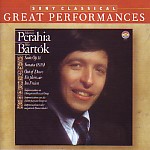It’s good to have all of Murray Perahia’s solo Bartok recordings together in one place. In fact, the pianist’s 1973 recording of the Sonata never has appeared on CD, at least in the U.S. The slightly dry and dynamically constricted sound quality I glean from my 25-year-old vinyl copy doesn’t come up much better in its digital transfer, even without pops and ticks. Still, it’s a marvelous performance, full of color, character, and rhythmic élan. Rather than treating them as faux percussion, Perahia brings out all the harmonic density in even the gnarliest chord clusters while making the most of the widely spaced accompanying chords. You don’t often think of Perahia as a thundering, extroverted virtuoso, yet listen to how easily he tosses off the final movement’s taxing octaves.
The delightful Improvisations on Hungarian Peasant Songs sounds remarkably crisp, impetuous, and texturally diverse in Perahia’s hands: what impeccably groomed trills and turns! The Op. 14 and Out of Doors suites equally impress, especially in the latter’s last movement (“The Chase”) where Perahia brings out the polyrhythms’ dance-like implications (in contrast to Zoltan Kocsis’ more driving, overt virtuosity).
In the Sonata for Two Pianos and Percussion the pianists favor relatively relaxed tempos that should allow the music’s contrapuntal give and take to truly manifest itself. But the main problem here concerns how the pianos are deployed. Why do Piano One and Piano Two keep switching positions in the first two movements? Do Solti and Perahia freely exchange parts, or is the editing wacky? In addition, the percussion balances are skewed, with the bass drum too reticent and the xylophone too far forward. You can do worse (the ugly, metallic Labeque sisters version or the surprisingly labored Richter/Lobanov), but you also can do much better (Argerich/Kovacevich, and my personal favorite, the Kontarsky brothers). My rating therefore reflects the solo works. When will Sony bring out the first CD release of Perahia’s Chopin Preludes?
































